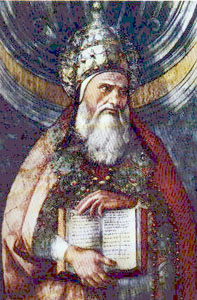
Pope Pius I is said to have been the Bishop of Rome from c. 140 to his death c. 154, according to the Annuario Pontificio. His dates are listed as 142 or 146 to 157 or 161, respectively.
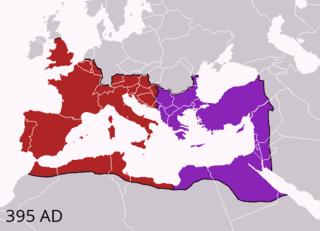
Year 395 (CCCXCV) was a common year starting on Monday of the Julian calendar. At the time, it was known as the Year of the Consulship of Olybrius and Probinus. The denomination 395 for this year has been used since the early medieval period, when the Anno Domini calendar era became the prevalent method in Europe for naming years.

Pope Hilarius was Pope from 19 November 461 to his death in 468.
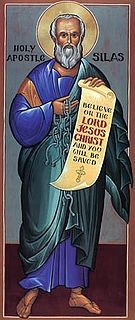
Silas or Silvanus was a leading member of the Early Christian community, who accompanied Paul the Apostle on parts of his first and second missionary journeys.

Saint NinoEqual to the Apostles and the Enlightener of Georgia was a woman who preached Christianity in Georgia, that resulted from the Christianization of Iberia.
Saint Pamphilus, was a presbyter of Caesarea and chief among biblical scholars of his generation. He was the friend and teacher of Eusebius of Caesarea, who recorded details of his career in a three-book Vita that has been lost.
Saint Dorothea of Alexandria is venerated as a Christian virgin martyr. Her legend states that the Roman Emperor Maximinus II courted her, yet she rejected his suit in fidelity to Christianity and virginity, and consequently he had her decapitated in c. 320.
Constantine-Silvanus was the founder of the Paulicians, a Christian movement in 7th century Armenia, who sought to return to the purity of the church in the time of Paul the Apostle. They were considered heretical by the Byzantine Church.

Assisi Cathedral, dedicated to San Rufino is a major church in Assisi, Italy. This stately church in Umbrian Romanesque style was the third church built on the same site to contain the remains of bishop Rufinus of Assisi, martyred in the 3rd century. The construction was started in 1140 to the designs by Giovanni da Gubbio, as attested by the wall inscription visible inside the apse. He may be the same Giovanni who designed the rose-window on the façade of Santa Maria Maggiore in 1163.
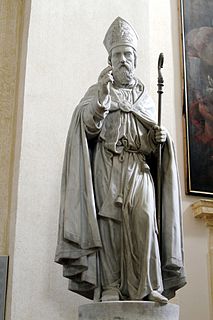
According to legend, Rufinus of Assisi, who is the patron saint of Assisi, Italy, was the first bishop of Assisi. He was responsible for converting Assisi to Christianity, but at what date is disputed. He is said to have died as a martyr at Costano, where the church was dedicated to him in 1038, and whence, according to Petrus Damiani, his relics were translated to Assisi in the 8th century. According to the Catholic Encyclopedia he is likely the same saint denoted under 11 August in the Roman Martyrology as Episcopus Marsorum.

St. Paul the Simple of Egypt was a hermit and disciple of St. Anthony the Great. St John, the Abbot of Sinai wrote "Paul the Simple was a clear example for us, for he was the rule and type of blessed simplicity." Though contemporaries, he is not to be confused with St. Paul of Egypt, regarded as the First Hermit. The account of his life is found in Palladius of Helenopolis De Vitis Patrum 8,28 and Tyrannius Rufinus Historia Eremitica 31.

Felicitas of Rome, also anglicized as Felicity, is a saint numbered among the Christian martyrs. Apart from her name, the only thing known for certain about this martyr is that she was buried in the Cemetery of Maximus, on the Via Salaria on a 23 November. However, a legend presents her as the mother of the seven martyrs whose feast is celebrated on 10 July. The Eastern Orthodox Church celebrates their martyrdom on 25 January.

Saint Chromatius was a bishop of Aquileia.
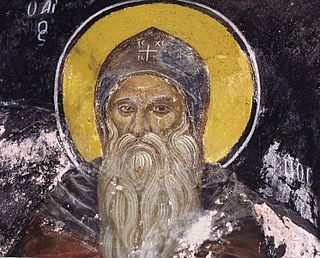
Saint Pambo is an Egyptian Desert Father of the fourth century. Saint Pambo is venerated by Roman Catholic Church and Eastern Orthodox Churches. Veneration day is 18 July.
Saints Rufus and Carpophorus were Christians who were martyred at Capua during the reign of Diocletian. Their Acta state that Rufus was a deacon.
Epenetus or Epaentus is a saint in the Greek Orthodox Church and Roman Catholic Church, considered one of the seventy disciples and may have been the first Bishop of Carthage or Cartagena. In the 16th chapter of St. Paul's letter to the Romans, Epenetus is referred to by Saint Paul as "my beloved" and given the great distinction of being named the "first convert in the Province of Asia".

Silouan the Athonite also sometimes referred to as Silouan of Athos, Saint Silvanus the Athonite or Staretz Silouan was an Eastern Orthodox monk of Russian origin, born Simeon Ivanovich Antonov who was a poet and monk of the St. Panteleimon Monastery.
The Roman Martyrology records eleven saints named Rufinus:
Alexander, known by the title comes, was a Byzantine diplomat. He was active in the reign of Justinian I. The main sources about him are Procopius, John Malalas and Theophanes the Confessor.












